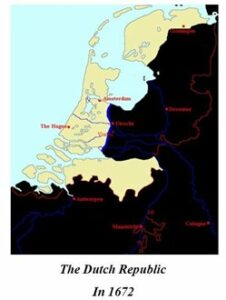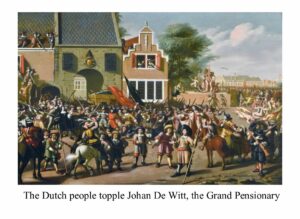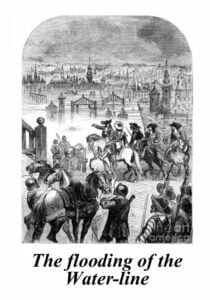 In Dutch history, the year 1672 is referred to as the Rampjaar (The year of Disaster).
In Dutch history, the year 1672 is referred to as the Rampjaar (The year of Disaster).
In that year the Dutch found themselves at war with all their surrounding countries and even, across the North Sea, with England!
They were fighting the French, in what was naturally called the Franco-Dutch War, at the same time as the start of Third Anglo-Dutch War. That year France, supported by Münster and Cologne, invaded the Dutch Republic, and nearly overrun it.
Why, you may well ask, did everyone want to invade Holland?
This is the interesting thing, it was a small country but was wealthier than the others, because the Netherlands were a republic not a Monarchy.
This upset the normal state of things and the other countries wanted to bring it down a peg or two.
The benefit of a Republic
To explain, it was ruled by the States General, a collection of delegates representing the United Provinces of the Netherlands. You see each individual province of the Dutch Republic was its own sovereign state, which then sent representatives to the States General. The States General then elected a Stadholder, who was in effect an elected King, and ran the show.
The problem was that this was of enormous financial benefit to the Netherlands.

To explain, Kings were expensive, they spent lots and lots of money. For example, Louis 14th built Versailles, it wasn’t cheap! This meant that to do this they borrowed, and they borrowed lots! Unfortunately, at that time the system was that when a king died, his debts died with him. Naturally, this had an effect on the interest rate the Kings’ paid to borrow.
However, with a republic its debts didn’t die as there was no King to die!
Therefore, the United Provinces of The Netherlands borrowed at a much lower interest rate. This allowed the Dutch merchants, capitalising on this lower interest rate, to sell their products abroad at a lower price. The result was that one of the smallest countries in Europe was, in fact, the most economically successful one in the late 1600s you could call them the Singapore of the 17th century.
What went Wrong?
Unfortunately, in 1672 it all fell apart. The French and two of the German Bishoprics, German Catholic states, massed on the Dutch border. While at the same time we, the English, tried to set up a naval blockade of the Dutch ports in support of the French.
This was a result of the Secret Treaty of Dover between the British King Charles II and Louis XIV of France. It was hidden as King Charles II of England agreed that at some future date England would become a Catholic nation again. At the time such a move would not have been popular.
In fact, 17 years later, it led to an interesting result, but more of that later.
 It was planned as a two-pronged attack on the Netherlands. The French were to invade from the south, while the Anglo-French fleet would land an army on the Dutch coast, bypassing the United Provinces’ defences.
It was planned as a two-pronged attack on the Netherlands. The French were to invade from the south, while the Anglo-French fleet would land an army on the Dutch coast, bypassing the United Provinces’ defences.
However, the Dutch snatched a naval victory at the Battle of Solebay on 28 May 1672 stopping the planned Anglo-French invasion of the northern Netherlands.
Then there was a revolution in the Netherlands, Johan De Witt, the Grand Pensionary, was toppled and replaced with a new Stadholder, William of Orange.
The situation looked bleak Prince William, as he now was, decided to concentrate his forces at the waterline.
The Waterline
This was a series of canals, put together by his grandfather, that he flooded making some of the states into a secure island.

This gave him time to strengthen the weak points in his defenses and train his army. With the result that by the autumn he had a force of 57,000 trained men behind the entrenchments, along with armed vessels patrolling the waterways.
The flooding of the waterline had an unfortunate effect, as those provinces outside the waterline fell to the French forces. It took a further year before William could sign a defensive alliance with the Holy Roman Empire, Brandenburg-Prussia and Spain against France.
Now other states started to fear Frances’s power, so they joined Prince William and within a year he had made the Netherlands free again.
17 Years Later
Prince William was an amazing man, who eventually married, Mary, the daughter of King James of England.
As I said earlier King Charles hid his treaty as the British were violently protestant, which led 17 years later to an amazing event. On 13th February 1689 William and Mary became King and Queen of England and two months later they became King and Queen of Scotland.
Imagine that 17 years after we had attempted to invade and lost several sea battles to them, the Dutch Stadholder became King of England and Scotland!
Isn’t history fun!
To learn more about this go to:
© Tony Dalton

